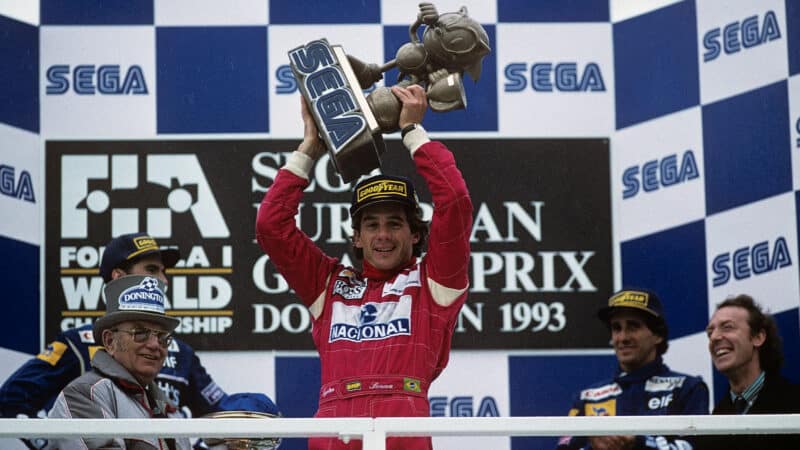The painting of Sonic’s legs on the pedals across the side of the FW15C is inspired, with there also being a lesser-known version that shows Sonic with his hand on a gearstick. There was even talk of sponsoring the underneath of the car for some more promotion in the event of a crash!
Sonic was also present on both Prost and Hill’s helmets that season, as well as Sega branding, which adorned the top of the lids and put them in a prime position when onboard cameras were used on broadcast. The race suits were a similar colour to that of the anthropomorphic blue hedgehog, so the sleeves featured further branding and when the drivers wore white gloves, they looked like Sonic’s arms.
The detail and sheer volume of Sonic marketing at Williams was intense, and so naturally made it an easy target for its competitors. Enter McLaren.
Alain Prost attempts a dignified pose with Sonic the Hedgehog-style gloves and hedgehog-branded helmet
Sutton Images
As outlined by Motor Sport in 2023, the Adrian Newey-designed 1993 Williams challenger was the most advanced F1 car ever to race and featured several features that included active ride, power steering, traction control, launch control, ABS and power-assisted brakes, and an early form of push-to-pass that was something akin to modern DRS. And in the background the team was developing a constantly variable transmission.
Driver aids were banned the following season, but the stats don’t lie and Williams picked up 10 wins across the 16 rounds – Prost with seven and Hill with three. The only threat to the FW15C was Senna, who achieved five victories for McLaren that season, with Michael Schumacher’s Benetton filling the other slot with his second career victory in Portugal.
It was this competitiveness that ignited a fun idea between the two powerhouse teams. For Williams, a sticker of Sega’s ‘Pirate TV’ logo would be added to the rear wing for every grand prix that it won that season.
In 1993 Williams f1 used the Sega skull logo to ‘etch’ each win on the rear wing of Prost and Hills car. I have an original unused sticker off one of the races they didn’t win… pic.twitter.com/dvPyRYiocn
— dom (@SRT40) April 4, 2023
The smart addition not only celebrated its successes but linked back to the odd adverts broadcast on British television used to promote the video games company. There are a couple featuring Damon Hill that remain on YouTube.
McLaren fought back, placing a squashed hedgehog on its MP4/8 whenever Senna had won a race, with chevrons that replicated the logo of the team’s sponsor Marlboro. It was a fun nod to each other, with McLaren’s former senior marketing manager Peter Burns confessing to the concept.
“I have to own up to being responsible for this idea, but I wasn’t sure of the internal reception we would receive from Ron Dennis,” he said in an article for Grand Prix 24/7. “Thankfully it appealed to his sense of humour and it was Ron who actually affixed the stickers onto the side of the cars of Ayrton Senna and [team-mate] Michael Andretti.”
In addition to the work at Williams, Sega sponsored the European Grand Prix that year. Much like the efforts with the race team, the event was an intense sea of white and blue with branding everywhere you looked. Grid girls were dressed as blue hedgehogs, massive blimps floated around the circuit and an enormous Sonic hot air balloon was seen looming over spectators. It looked like a fever dream.
Sonic the Hedgehog grid girls brave the Donington rain
Sutton Images
“It was a ‘floating’ Grand Prix and no one else wanted to sponsor it,” Simon Morris, the marketing director at Sega Europe from 1989 to 1994, recalled. He also indicated that it unsurprisingly cost them a lot, and his team received some disapproval from those higher up than him, but in the end it turned out to be a triumph.
Thanks to the soggy East Midlands weather, and Senna’s formidable ability to drive in the wet, the race is now cemented into motor sport history as the scene of his “Lap of the Gods”. The Brazilian, who started fourth, passed Schumacher, Hill and Prost on the opening lap to take the lead and eventually win the race.
He was then awarded the notorious Sonic silverware, before the real trophies were handed out to Senna and Ron Dennis respectively on the podium. Some could say it was McLaren who won that round, with neither of the Sega-sponsored drivers able to stand on the top step of the podium.
A unique trophy for one of F1’s great virtuoso drives
The Japanese video game company disappeared from the grid in 1994, with Senna making the switch to Williams after Prost’s departure.
Perhaps this current opportunity between McLaren and Sonic is a chance to unlock a new chapter of the iconic hedgehog’s role in the sport, and give Williams a little nudge to level up.




